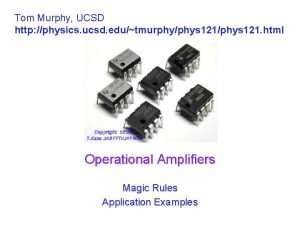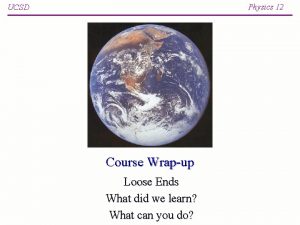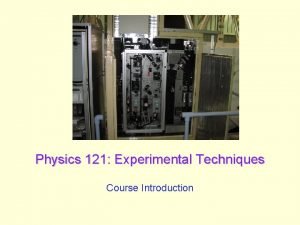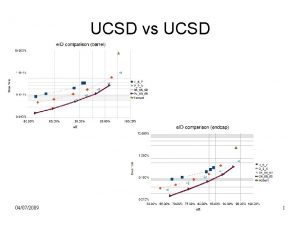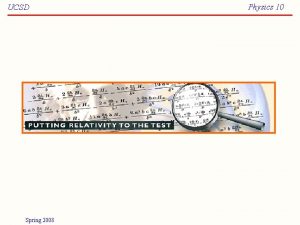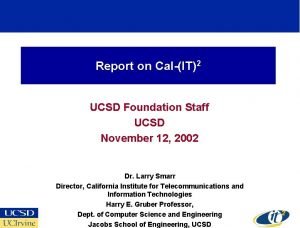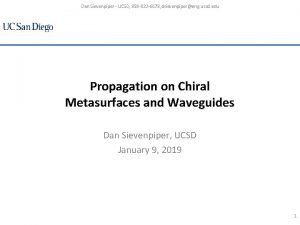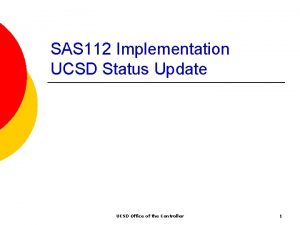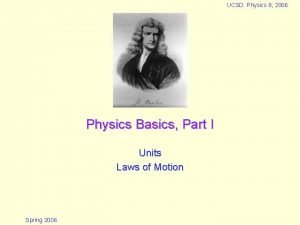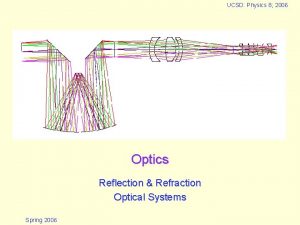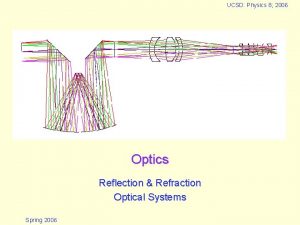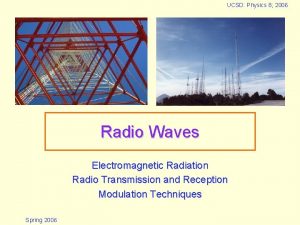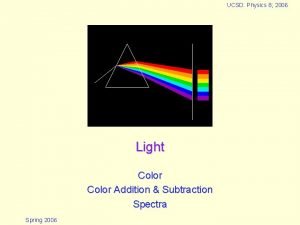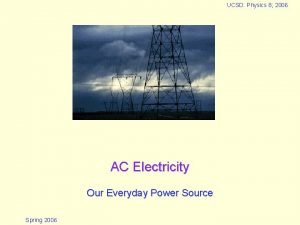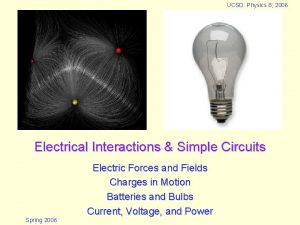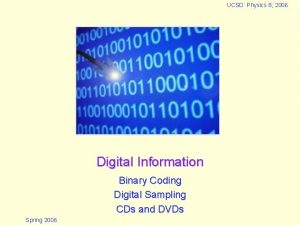UCSD Physics 8 2006 Physics 8 The Physics

















- Slides: 17

UCSD: Physics 8; 2006 Physics 8: The Physics of Everyday Life Tom Murphy Spring 2006

UCSD: Physics 8; 2006 Course Goals • Explore what physics has to say about the world we live in – Physics has A LOT to say!! • Understand how some of our technological gizmos work – – – TV, radio, cell phones Computers Microwave ovens GPS Electricity generation and use • Look at the physics of living – Food, exercise, radiation/cancer Spring 2006 2

UCSD: Physics 8; 2006 Course Goals, continued • Learn to be more aware of physics in our lives – Bi-weekly questions force you to do this • Watch lots of cool demonstrations • Ask lots of questions – Let curiosity run free • Explore the physics of our perceptions – Sound, light, temperature • Steer the course to match your interests • Decide that physics is way cool, and not the worst course you ever had in college Spring 2006 3

UCSD: Physics 8; 2006 Course Structure/Grading Scheme • 25% based on weekly homework • 10% based on bi-weekly question/observation submissions • 30% based on midterm exam • 35% based on final exam • Up to 15% based on classroom participation – As determined via transmitter activity – Applied to lowest exam score as “automatic” points – Example: 80% attendance gets you 12% credit, so midterm would be worth 18% or final worth 23% Spring 2006 4

UCSD: Physics 8; 2006 Question/Observation Submission • This is a course about curiosity • Bi-weekly questions/observations get you to participate in this feature of the course – Something you’ve always wondered about – Something you recently noticed – Something that class prompted you to think about • Goal is to increase your awareness, observational skills – We’re immersed in physics: easy to ignore, but also easy to see! – You’ll begin to think more deeply before shoving problem aside • Submission via Web. CT (establish SOON!) Spring 2006 5

UCSD: Physics 8; 2006 Question/Observation Examples • Why do my cheerios cluster together in a little flotilla? • Why does spaghetti get flexible right away when cooking, but takes a long time to be soft enough to eat? • I’ve seen wheels on cars on the freeway at night appear to spin backwards, but have never noticed this during the day. Maybe it has something to do with the lighting… • When I turn off my TV, the picture collapses into a small point in the center of the screen. I think this is cool, but would like to know why. • More examples appear on website: – http: //physics. ucsd. edu/~tmurphy/phys 8/questions. html Spring 2006 6

UCSD: Physics 8; 2006 Transmitters • We will use in-class response system to engage the class • This system has the following advantages: – – Stimulates discussion among students Provides practice on quiz-like questions Gives students feedback about what they do/don’t get Gives instructor feedback about what has/hasn’t been covered well – Provides mechanism for participation credit – Keeps class awake! • Purchase at Bookstore (or acquire from other student) – Only the 13 -button remotes work • Register your number via Web. CT “quiz” Spring 2006 7

UCSD: Physics 8; 2006 Web. CT Access • Web. CT provides a means to: – – – – Access grades Submit bi-weekly questions/observations Register transmitter Communicate with students, TA, professor in chat forum Links to course website, assignments, online lectures Homework solutions Etc. • How do you access it? – Unless you’re an extension student, you will automatically get an account about one day after registering for the class – your password is the same as your ACS password for e-mail – see instructions linked from course website Spring 2006 8

UCSD: Physics 8; 2006 Resources • Fellow students! – You are encouraged to work together on HW, studying, etc. • Website: – http: /physics. ucsd. edu/~tmurphy/phys 8. html – Assignments, lectures, announcements, etc. – Web. CT site • Teaching Assistant – Matthew Le. Bourgeois: office: Mayer Hall 2101: Wed. 2– 3 PM; discussion & problem sessions • Professor – Tom Murphy: SERF 336: Thu. 11: 00 AM–noon • Text – How Things Work: The Physics of Everyday Life, 3 rd edition, by Bloomfield Spring 2006 9

UCSD: Physics 8; 2006 Extra Sessions • Discussion section: Wednesday 4: 00– 4: 50 PM in Center 214 – Led by Matt – Focus on understanding concepts, mock quizzes, help with homework, actual discussion!! • Problem session: TBA – Focus on solving problems of the type seen in homework and on quizzes – More quantitative than discussion section Spring 2006 10

UCSD: Physics 8; 2006 How much Math? • The course is mostly conceptual/qualitative • But part of the power of physics is its quantitative description of our world – Some experiments in physics show adherence to model to 14 digits of precision!! • We’ll dabble in the numbers, but it’s never more complicated than , , –, +, yx, and maybe averaging • Sometimes we must rearrange an equation: V = IR becomes I = V/R • There will be some seat-of-the-pants estimation problems too – This may prove to be the hardest aspect, but not because of the math—it’ll be because this is unfamiliar turf… Spring 2006 11

UCSD: Physics 8; 2006 Expectations • Attend Lectures and Discussion Sections • Participate! – If it doesn’t make sense, ask! Everyone learns that way. – Don’t be bashful about answering questions posed. – In-class voting system should make this fun • Do the work: – It’s the only way this stuff will really sink in – exams become easy • Explore, think, ask, speculate, admire, enjoy! – Physics can be fun, enriching, beautiful Spring 2006 12

UCSD: Physics 8; 2006 Any Questions on Course Structure? Spring 2006 13

UCSD: Physics 8; 2006 A Crude Roadmap • First couple weeks covering physics basics – Motion, energy, force, power, electric forces, etc. – We’ll pick up other physics as we go • The energetics of life – Eating, exercising, fighting air & water • What can we see? – Light, color, weird natural phenomena • What can’t we see? – Other electromagnetic radiation & application to cell phones, TV, radio, microwave ovens, heat (infrared), GPS • What can we hear? – What is sound? How do speakers, CDs, ears work? Spring 2006 14

UCSD: Physics 8; 2006 Roadmap, continued • How do we handle information? – Digital storage, logic, computers, compression • How do we get work done? – Generating electricity – Using electricity to do work: basic circuits – The insides of our electronic devices • Last part of course can follow student interest – Topics of interest can come from bi-weekly Q/O, voting via transmitter, e-mail to professor, spontaneous class discussions – Keep your eyes open for things you’d like to know more about – Look at your book to stimulate ideas Spring 2006 15

UCSD: Physics 8; 2006 What kinds of things will you learn? • How to look at circuit diagrams without being frightened • How to look at your broken radio and point out resitistors, transistors, capacitors, diodes, ICs • How your remote control works (and see it work!) • How the music you hear is recorded, digitized, stored, replayed • How TV signals carry video information that you then see on the screen as an image • How binary logic works and how this is implemented in computers as transistor blocks • How much energy you’ll use keeping your house warm Spring 2006 16

UCSD: Physics 8; 2006 Assignments • Check out the course website: http: //physics. ucsd. edu/~tmurphy/phys 8. html • Establish Web. CT connectivity & register transmitter • Read Chapter 1 of book – You can skip sections on velocity, position of falling balls, as well as section on projectile motion (pp. 15– 21) • Transmitters will start counting for credit Tuesday 4/11 • First HW will be due Thursday 4/13 • First Q/O due Friday, 4/14 by 6 PM via Web. CT� Spring 2006 17
 Ucsd physics
Ucsd physics Phys courses ucsd
Phys courses ucsd Ucsd physics courses
Ucsd physics courses Ucsd physics courses
Ucsd physics courses Lời thề hippocrates
Lời thề hippocrates Glasgow thang điểm
Glasgow thang điểm đại từ thay thế
đại từ thay thế Vẽ hình chiếu đứng bằng cạnh của vật thể
Vẽ hình chiếu đứng bằng cạnh của vật thể Quá trình desamine hóa có thể tạo ra
Quá trình desamine hóa có thể tạo ra Thế nào là mạng điện lắp đặt kiểu nổi
Thế nào là mạng điện lắp đặt kiểu nổi Khi nào hổ con có thể sống độc lập
Khi nào hổ con có thể sống độc lập Các châu lục và đại dương trên thế giới
Các châu lục và đại dương trên thế giới Dạng đột biến một nhiễm là
Dạng đột biến một nhiễm là Biện pháp chống mỏi cơ
Biện pháp chống mỏi cơ Bổ thể
Bổ thể Phản ứng thế ankan
Phản ứng thế ankan Thiếu nhi thế giới liên hoan
Thiếu nhi thế giới liên hoan Fecboak
Fecboak
